Longhouse Culture in Sarawak, Malaysia Borneo

Are you looking for a unique and memorable way to learn about the indigenous people of Borneo? Do you want to immerse yourself in their longhouse culture and way of life? In which case, you should consider visiting a longhouse in Sarawak, Malaysia Borneo. There are over 4,500 longhouses spread all over Sarawak. This article focuses on traditional longhouses that often receive paying visitors. They represent the main three ethnic groups of Sarawak; the Ibans, Bidayuhs and Orang Ulus. Each with their own rich and fascinating history and culture.
This blog is structured as follow:
What is a Longhouse?
A longhouse is a (wooden) structure built on stilts. Usually along a river bank. A row of separate family rooms (bilik) sectioned off along an open social area and meeting space (ruai). The more doors there are, the longer…the longhouse is! There can be as many as 100-door ones. A longhouse accommodates many families living together under one roof. It is the center of communal life of the various indigenous groups.
Longhouses are often located along river banks. This means that long boats are the main mode of the people’s transport. But over time, development has resulted in road access and improved living standards for many. (More in our ‘What to Expect’ section). In this regard, these longhouses have given way to modernity. For some, the tragic tale of fire meant a rebuild. Nonetheless, the layout of these structures remain the same, which we have shared an academic paper to drill down to.
This paper is a useful background read before a longhouse visit. The Egalitarian Architecture of the Iban Longhouse (pdf) Dr. John Ting, Assistant Professor at University of Canberra, Australia
What to Expect?
Some of the things that you can expect from a typical longhouse culture experience are:
- Your host will invite you to join them for meals, which are usually cooked over a fire and served on the floor.
- You will get to taste their local delicacies, such as rice, fish, chicken, vegetables, and fruits.
- In addition, he will offer homemade rice wine, tuak, that is often drunk during celebrations. This is the time when you can get carried away… for the sake of a good time!
- Longhouse folks will entertain you with music and dance performances. At the same time, you will see them play their traditional instruments. They include gongs, drums, and sape (string instrument). The sape is synonymous with the Orang Ulu community. Watch them perform their graceful ‘ngajat’ or the hornbill dance. You will learn some of their moves. For being a good sport, you get a crash course in how to be ungracefully… graceful.
- You will see human skulls hung in some of the longhouses you visit. The remnants of old headhunting practice.
- Above all, one has to manage his or her expectation of authenticity and traditions of a longhouse. Keeping up with development is a facet of progress no matter how rudiment a rural setting is. Sarawak is no exception. Thus, it presents a great opportunities to learn the impact different aspects of modernity has on a longhouse community. Notwithstanding this paradigm shift, a thorough pre-tour briefing (if buying a tour) prepares one for a better longhouse experience.
Outdoor Activities
- You will be able to explore the surrounding nature and wildlife of the longhouse.
- You may also visit nearby waterfalls, caves, or rivers, where you can swim or relax.
- You will learn how they use the natural resources of the jungle to make baskets, mats, and ornaments. As an example, the Penans at the Long Iman longhouse are deft at making rattan handicrafts. And the Ibans with their pretty ‘pua kumbu’ textile weaving.
- You will be able to take part in activities such as weaving, fishing and farming.
- You will learn how the locals cook your meals in bamboo in the wild.
Listen to your guide on the etiquettes and rules of the longhouse. Since they may differ from one another owing to localised taboos. Therefore, you should always ask for permission to do things if you are not sure. For example taking photos or touching things
Where to Go ?
In this blog, we highlight the popular longhouses in the respective administrative divisions. Included in our list are the interesting aspects of the respective longhouses. Their unique selling proposition if you like. The main ethnic groups covered are the Ibans, Bidayuhs and the Orang Ulus. The Kenyahs, Kayans, Penans and Kelabits fall under the Orang Ulu sub-groups.
Jump Links to The Following Places Mentioned:
- Kuching – Capital City With Colonial Charm (Bidayuhs)
- Sri Aman – Longhouse Culture, Traditions and Rainforest Thrive (Ibans)
- Sibu and Sarikei – Along the longest river in Malaysia (Ibans)
- Kapit – Into the Headwaters of Borneo (Kayans and Kenyahs)
- Miri – World Heritage and Highlands Ibans, Penans and Kelabits)
Follow this place map for all the longhouses mentioned in this article.
Kuching – Capital City With a Colonial Charm
The capital city, Kuching is the starting point for both day and multi-day trips. The same applies if you were to go to places in the Sri Aman, Betong Division and beyond. Aided by the new Pan Borneo Highway, the game changer for land travel in Sarawak.
Nonetheless, Kuching is the primary gateway city for foreign travellers to Sarawak
One can make a day trip to Annah Rais and Mongkos Bidayuh Longhouse. The former is a cluster of 5 longhouses numbering 80 doors. Homestays are available at these two places for longer stay.
Annah Rais is an hour’s drive from Kuching. It is the oldest Bidayuh village in Sarawak. Its history dates back to 175 years ago. The highlights of this longhouse are the well-maintained bamboo floorings and headhouse. Human skulls from old practice are still kept in the ‘Panggah’ (headhouse). There is a hot spring nearby and jungle treks to sweat out in. Tip: Stop at the Semenggoh Wildlife Center along the way to see semi-wild orangutans.
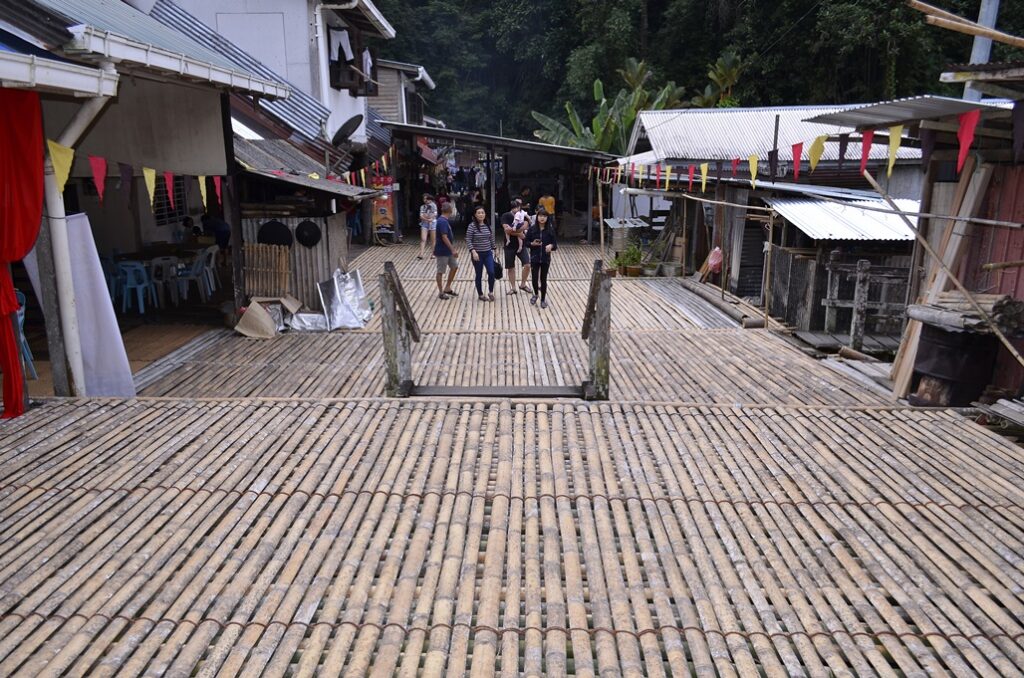
Two hours away in the same general direction is the 24-door Mongkos Bidayuh Longhouse. It is another one of few remaining traditional Bidayuh longhouses in Sarawak. It is also popular with Kuching-based tour operators for day trips and overnight ones. Activities include farm life, cultural immersion and lifestyle.
The 20-door Kampung Pueh Bidayuh Selako longhouse is a stone throw away from the South China Sea. Unlike their counterparts found along rivers. In other words, a beach experience can be had. The Salako is a Bidayuh sub-dialectal group differing in dialect, costumes and practices. It is a 90-minute drive from Kuching.
A Muslim Longhouse
Half an hour drive from Annah Rais, is the 40-door Kampung Belimbing Darul Islam longhouse. It offers visitors a different perspective of the Bidayuh culture. A section of the original longhouse has hived into another one next door. To conform to certain aspects of the Islamic teachings. When in bloom, visitors can view the largest flower in the world, the rafflesia, in the jungle nearby.
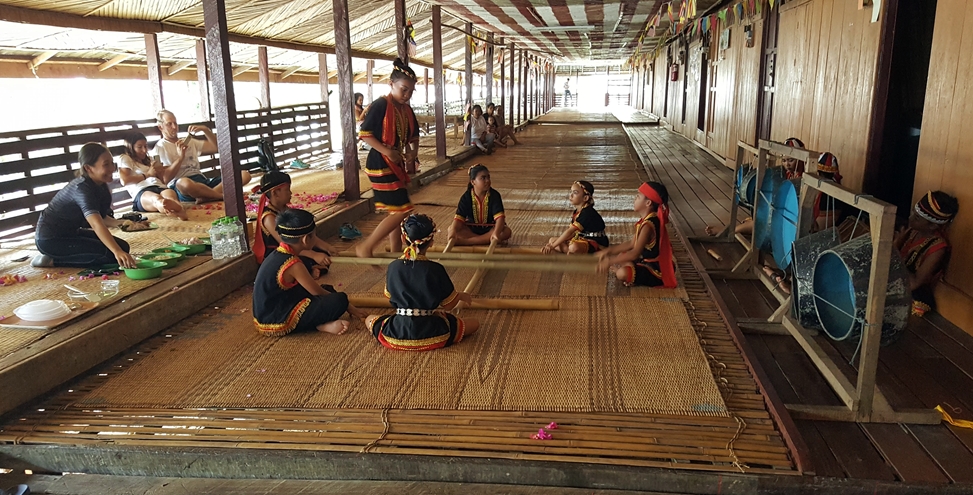
When You Are Short of Time in Kuching
There will be those who are on a short business or conference trip to Kuching. In which case, the Sarawak Cultural Village is a good place to get a feel of longhouse culture. It is a living museum depicting the ethnology of Sarawak’s ethnic groups. Among others, the replica building of an Iban, Bidayuh and Orang Ulu longhouse fits the bill.
For a less immersive but educational experience, head to the Borneo Cultures Museum. Level 3 of the 5-story building contains exhibitions of local communities. It explores their relationship with the natural environment based on a river journey.
Bordering Kuching Division is Sri Aman.
Sri Aman Longhouse Culture – Traditions and Rainforest Thrive
The Batang Ai region in this division is one of the best places to visit an Iban longhouse. The buildings are traditional and lifestyle, rustic. Travel to this area is a combination of road and river adventure. Longboat travel makes it an interesting affair for first timers.
Regardless of which longhouse to visit, one has to make a 3 3/4-hour road trip from Kuching first. Subject to the number of convenient stops along the way. Before the completion of this stretch of the Pan Borneo Highway in mid-2023, it would take 5 hours.
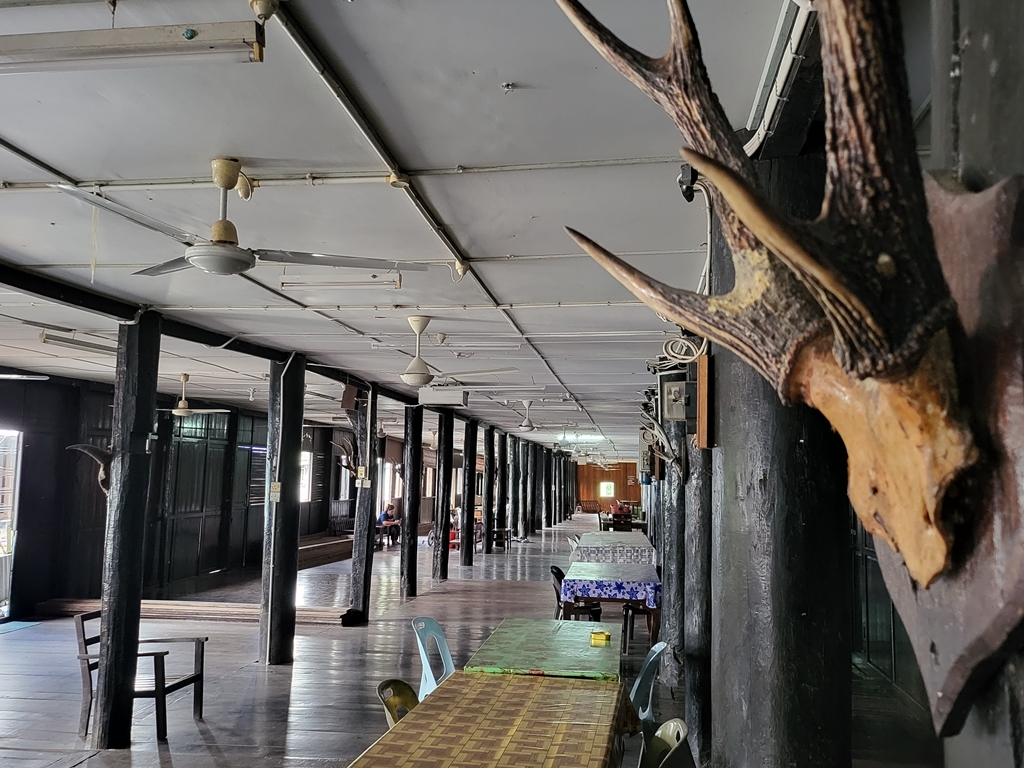
The man-made Batang Ai Lake is at the center of the tour programme. The jetty here is the beginning of the boat journey to the longhouses. And to the Batang Ai National Park to do wild orangutan spotting. This region is Sarawak’s prime destination for cultural traditions and rainforest experiences. For some it was philosophical. A place where the late Anthony Bourdain visited twice. Got his tattoos and promise fulfilled.
The shortest duration for a visit is 3 days 2 nights for the longhouse culture experience. For this, the service of a tour operator is a must. If anything else, the ground arrangement is a resource intensive affair. Furthermore, guests stay at facilities managed and owned by tour operators themselves. A fact not lost on proponents of sustainable/responsible tourism. Visitors stay and eat in their own quarters annexed to the longhouse proper. Thus mitigating societal impact on the local way of life. Above all, such facilities provide decent creature comfort for city folks.
In Batang Ai
First off is the 36-door Nanga Ukom Longhouse. It is the oldest longhouse in Batang Ai. It was rebuilt after a fire razed it down in 2015. But the longhouse is still as traditional as one can experience. Its isolation has kept it that way. Her dwellers are as welcoming. The only way to get there is a 1-hour boat journey. There are the waterfalls to dip into, the ridges to trek and farming to experience. Aside from the evening of merry makings.. And longhouse folks are masters of such!
Further up the Delok river, still within the Batang Ai lake, is the 30-door Nanga Sumpa longhouse. It is far upriver enough to push longboats during low water levels. The 1 1/2 ride is your Tranquility Express to a world of dense jungle, pristine river and wild orangutans. Different from Nanga Ukom, you stay in a lodge built next to the longhouse. Hence, you only interact with the community during the social evenings.
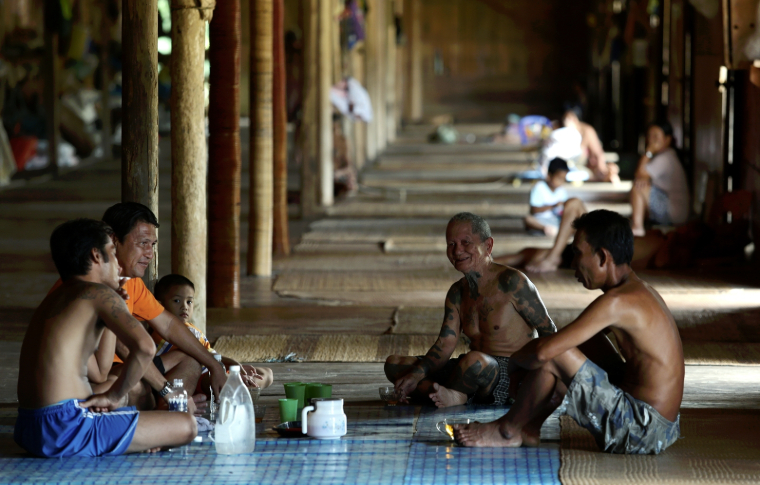
Still within the confines of the Batang Ai Lake, lies the 31-door Rumah Sambau Mengkak. The use of tree bark as wall material gives the place the traditional ambience of old. This Iban longhouse is an hour boat ride from the Batang Ai Lake jetty.
These longhouses exemplify the best practices of responsible tourism in Sarawak. Long before it became a catchphrase in the state tourism industry’s lexicon.
In Sri Aman
At a different region of Sri Aman lies another Iban longhouse. The reference town is Simanggang, the administrative center of the division.
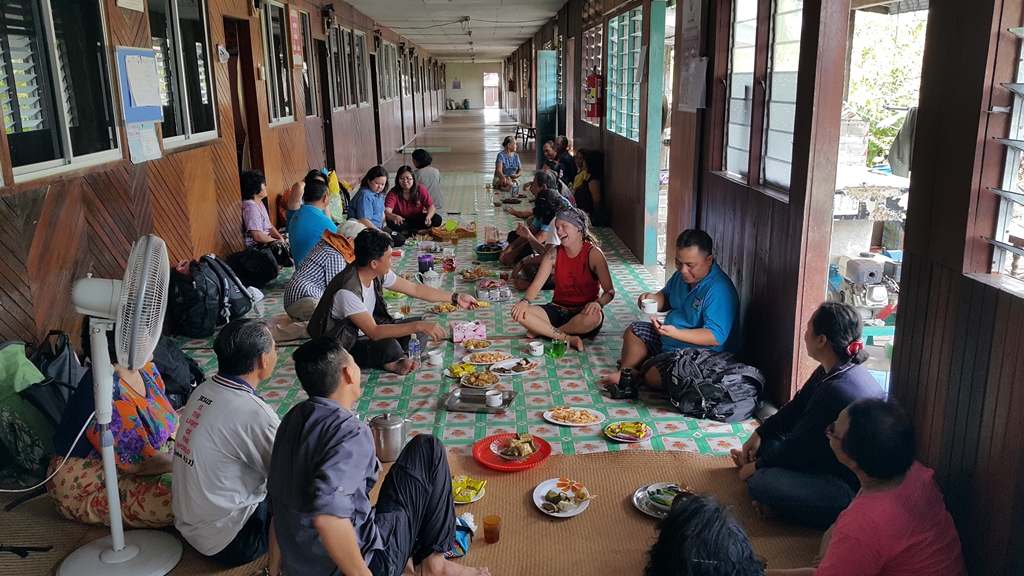
Eating with Ibans on the floor of Rumah Encharang, BantingIt’s the 19-door Rumah (House) Encharang, Banting. For now* Getting there takes a 3 1/2 hour drive from Kuching and a further 1-hour drive from Simanggang to Lingga. From the jetty here, it is a 2 hour river journey to Banting.
Banting was the first place in rural Sarawak to get an Anglican Church in 1859. With that came along western education and healthcare. This was during the reign of the first White Rajah of Sarawak, Sir James Brooke. The complete belian place of worship remains in use today.
The river journey is an adventure in itself. Often one can spot estuarine crocodiles basking along the river banks. They thrive on the abundant sizable freshwater prawns in the river. Local folks do that too. And so will you at dinner time.
While here, the view of 1,865m high Gunung (Mt) Lesong stays with you. This table top mountain dominates the national park of the same name. For the locals, it is a prayer mountain. To the wild orangutans, it is home. At the moment, the wild orangutan experience is in the research and conservation domain.
*A new road access from Simanggang to Banting is now in the works.
The dual-carriageway Pan Borneo Highway has resulted in new longhouse culture experiential combinations. Constrained by travelling time in the past, one is now able to explore further up this new Highway. Paradesa Borneo’s 8-Day Sarawak Coastal and Interior Explorer is a good reference programme.
Sibu and Sarikei Longhouse Culture – Along the longest river in Malaysia
The longest river in Malaysia is the Rajang river. At 350-km long, it flows through these three divisions. Sibu is the gateway town with an airport that connects to major cities and towns in Malaysia. Sarikei lies downstream from Sibu and Kapit upstream.
Where the river flows, longhouses abound. The Iban, Kayan, Kenyah longhouses dominate the Rajang river basin. We cast our attention on the Iban longhouses in the Sarikei and Sibu division. And the Kayan and Kenyah (Orang Ulu sub-groups) longhouses in the Kapit division. Farm life, hiking and waterfalls are the common attractions.
The days of boat access to longhouses are days of old now. Improved road infrastructure has meant ease of public access. Longboats are for those hunting and fishing trips nowadays. For some, it’s tending to their farms on the opposite bank of a river.
Thus making day trips possible. Although overnight stay is a must for a richer experience.
In Sibu
Much nearer to Sibu is the cluster of longhouses at Bawang Assan. It takes 40 minutes to reach there. The same goes to Rumah Penghulu Philip Kayak but in a different direction at Durin. In the same direction, an hour away from Sibu is the 64-door Rumah Joseph James. The other is the 21-door Rumah Margretta.
It has to be said that the longhouses around Sibu have undergone makeovers over the years. So do all longhouses for the rest of Sarawak. It also means a decent level of facilities enlivened with traditions and warm hospitality.
In Sarikei
The 33-door Rumah Sibar, Sarikei is a beautiful belian longhouse popular with visitors. The popularity of this longhouse began when it was called Rumah Nyuka. However, in keeping with Iban culture, names of longhouses change upon the appointment of a new headman. It is a 3-hour round trip from the town of Sibu.
Kapit – Into the Headwaters of Borneo
Upstream from Sibu is Kapit, a 3-hour long journey. However, with the completion of a road linking Sibu and Kapit has meant that boat service is now taken over by bus service.
The Kayan and Kenyah longhouses lie in the headwaters of the Rajang river. In the old days, accessibility was from the town of Kapit. A tough adventure river travels with the infamous Pelagus Rapids to shoot. One can still do the boat trip but via Belaga, a 5-hour journey away. From here, it is a 2-hour drive to Sungai Asap. Nowadays, a road trip from the town of Bintulu to these longhouses at Sungai Asap is between 2 1/2 to 3 hours.
The 101-door Kayan Uma (house) Belor is a fascinating structure. A row of seven blocks joined by covered walkways makes it the longest of them all. 6-km up the road is the Kenyah Uma Baha/Bakah. A cluster of 300-door in total.
Kapit – Into the Headwaters of Borneo
Upstream from Sibu is Kapit, a 3-hour long journey. Regular fast boat services still serve this route. The bus service from Sibu is an alternative 3-hour road trip.
The Kayan and Kenyah longhouses lie in the headwaters of the Rajang river. In the old days, accessibility was from the town of Kapit. A tough adventure river travels with the infamous Pelagus Rapids to shoot. One can still do the boat trip but via Belaga, a 5-hour journey away. This service runs every two days from Kapit. From Belaga, it is a 2-hour drive to Sungai Asap. Nowadays, a road trip from the town of Bintulu to these longhouses at Sungai Asap is between 2 1/2 to 3 hours.
The 101-door Kayan Uma (house) Belor is a fascinating structure. A row of seven blocks joined by covered walkways makes it the longest of them all. 6-km up the road is the Kenyah Uma Baha/Bakah. A cluster of 300-door in total.
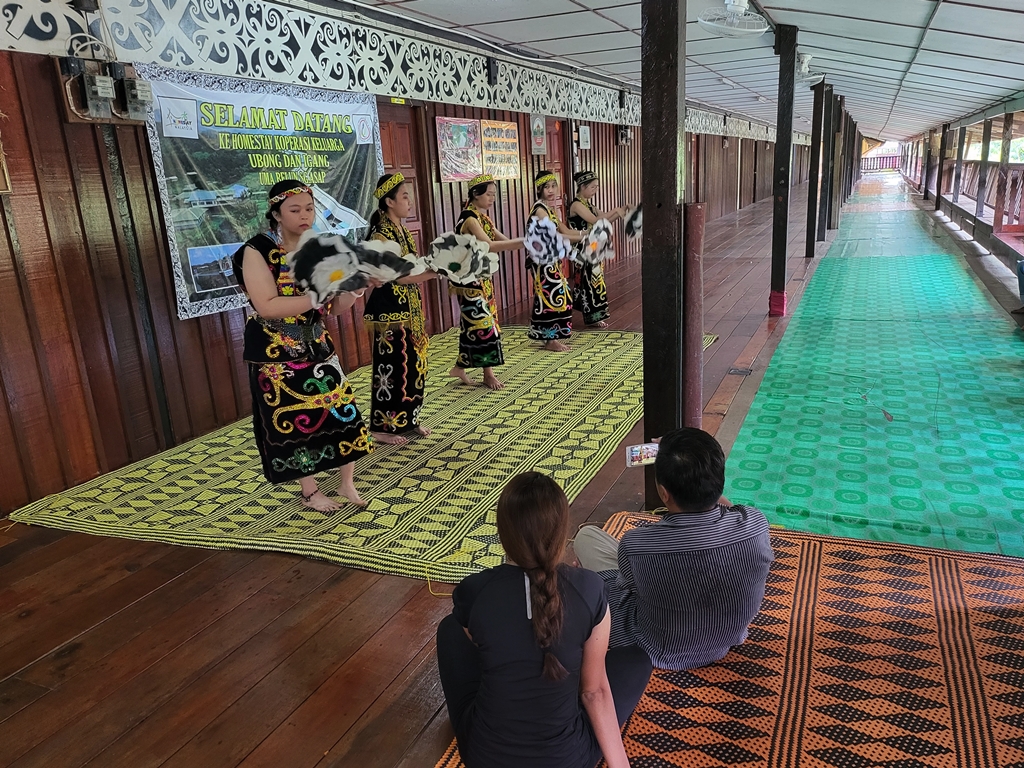
There is a reason for such high population density at Sungai Asap. In the past, Kayans and Kenyahs lived along the stretches of the Balui river, a tributary of the Rajang river. A hydroelectric dam resulted in a huge resettlement scheme at Sungai Asap.
The Kayan and Kenyah are sub-groups of the Orang Ulu. Despite having cultural similarities, the Kayan and Kenyah are two distinct groups. In addition, they have their own languages and cultural practices. And Sungai Asap is one place in Sarawak where one can still meet women with tattooed forearms.
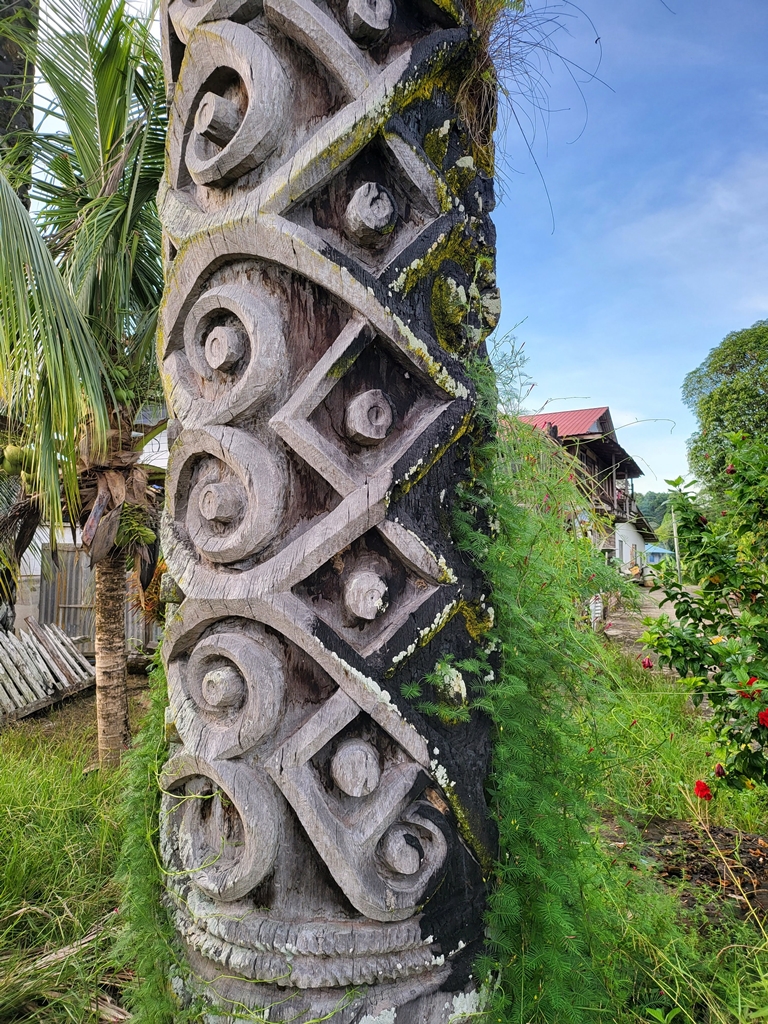
Tip: For the latest longhouse visit and transport schedules ex-Sibu, contact the Visitor Information Center, Sibu.
Miri – Highlands and World Heritage
There are some interesting dimensions for longhouse culture experience in Miri division. A town built from the oil and gas industry. It borders the royal sultanate of Brunei Darussalam.
Next to a national park, lies an Iban longhouse. On the fringe of another, there is a Penan one. One of these national parks is on the World Heritage Site Tentative List. And the other is a World Heritage Site. And up in the highlands, you can visit a Kelabit longhouse.
Rumah Patrick Libau is a 30-door Iban longhouse next to the Niah National Park. Its significance is the archaeological heritage of the cave complex. The Sarawak government is now bidding for a World Heritage inscription. The main Great Cave is a 20-minute plank walk stroll from the longhouse. It takes an hour and 45 minutes drive to get to Rumah Patrick Libau from Miri City
From the Mulu World Heritage Site, the 59-door Long Iman Penan Longhouse is a popular option. This Penan settlement is an hour river travel, sited on the bank of the Tutoh river. Though nomadic by nature, some Penans have carved out a different lifestyle. And putting their handicraft making skills to good use.
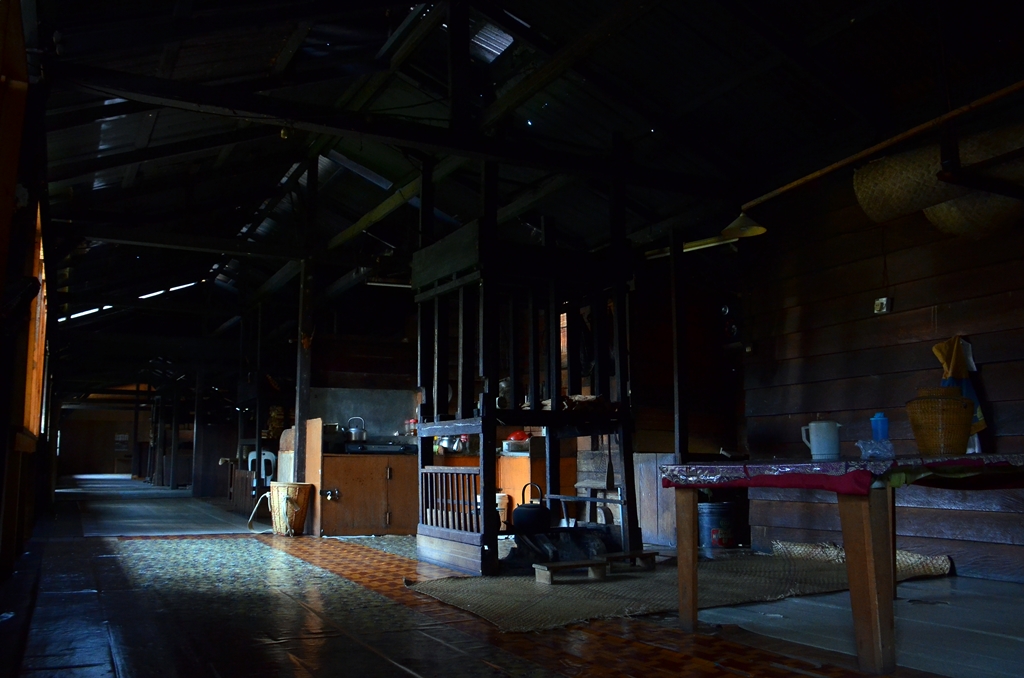
The Highlands of Sarawak
Like Mulu, flying is the preferred mode of transport. Unlike Mulu, you will board a 17-seater Twin Otter plane for the 50-minute non-stop flight to Bario. The ATR 72 seater serves the Miri-Mulu sector. Bario lies at an altitude of 1,000 m in the Kelabit Highlands. For this fact, the longhouses differ from those in the lowlands. Each unit has an open hearth by design. To keep warm on cold nights. A visit to the 22-door Rumah Bario Asal is as heart warming as a stay there.
Tip: For the latest longhouse visit ex-Miri, contact the Visitor Information Center, Miri.
Preparing Your Longhouse Culture Visit
A longhouse culture experience is a rewarding and memorable adventure. However you need to have some preparation and a state of mind. Here are some tips on how to prepare for a longhouse experience:
- Pack light and bring only the essentials. Bring comfortable clothes, shoes, toiletries, insect repellent, sunscreen, flashlight, poncho, and water bottle. In other words, prepare how you would if you go camping. Take into account the high humidity minus the extreme temperature range.
- You may also want to bring some snacks, gifts, or donations for the people, such as books, pens, toys, or clothes.
- You should also take in the activities and ceremonies. This shows your appreciation and gratitude to your host. But do mention to your guide if you can’t oblige on medical or religious grounds.
- You should also prepare to adapt to their living conditions. A general rule of thumb is the more isolated a longhouse is, the more basic are the amenities. You may have to sleep on a mattress under a mosquito net, use a squat toilet or shower with cold water.
- You should also be aware of the potential risks such as insects, animals or diseases. Take the necessary precautions.
How to Visit a Longhouse ?
Sarawak is the largest state of Malaysia. For context it’s land area is 96% of the whole of the Peninsular Malaysia. This article bears testimony to the scope and opportunities at your disposal.
This article began in Kuching for the Bidayuh longhouse culture experience. The Ibans in the Sri Aman Division. In the central region of Sarawak, it was a blend of Iban and Orang Ulu. It is similar in northeastern Miri Division. Only difference is that the Orang Ulu sub-groups involved are the Kelabits and Penans.
You can visit a longhouse on their own or through a local tour operator. Longhouses that are near urban centers can be a do-it-yourself arrangement. You can hire a car hailing/transporter service to get you there and back. Often this would be a half/day trip. As such, it is a walk from your lodge in Bario. Assuming you are already in this highlands.
Despite the advent of digital tools, experiential travel arrangement remains fragmented, a tour operator is recommended for rural trips. Ground travel arrangements involve different transfer modes and schedules. Longhouses here work with licensed tour operators for trust and convenience.
Getting More Information
The Visitor Information Center in Kuching, Sibu and Miri are the first places to enquire at. Where you get the latest information on ground and travelling conditions. The information include weather (flood), death at a longhouse or festive events that may restrict entry. On death, the longhouse name changes according to the name of the new headman. The Visitor Information Centers operate under the auspices of the Sarawak Tourism Board.
For tours and activities providers like Paradesa Borneo, we organise such cultural tours. Our reputation is supported by our Tripadvisor Travellers’ Choice 2023 award. If a customised tour is what you look for, we look forward to your email enquiry.
Written by: Team Paradesa Borneo